Health Workforce Plan: Analyzing Kenya's Healthcare Shortage
VerifiedAdded on 2022/12/09
|14
|4046
|134
Report
AI Summary
This report presents a comprehensive analysis of Kenya's health workforce plan, focusing on the critical shortage of healthcare workers. It begins by establishing the context and environment, detailing the external and internal factors influencing the health sector, including the global health worker shortage and Kenya's own healthcare infrastructure. The report then provides a detailed profile of the current health workforce in Kenya, highlighting the gap between the existing numbers and the WHO-recommended standards. It projects the future workforce profile, anticipating continued shortages due to population growth and attrition. A key component of the report is the gap analysis, which identifies the reasons behind the workforce shortage and proposes closing strategies. These strategies include increasing the enrollment of health professional students, improving the working conditions and compensation of health workers, and strengthening human resource policies. The report also evaluates the plan's performance, suggesting metrics to measure its effectiveness and outlines the next steps required to address the challenges and improve healthcare delivery in Kenya.
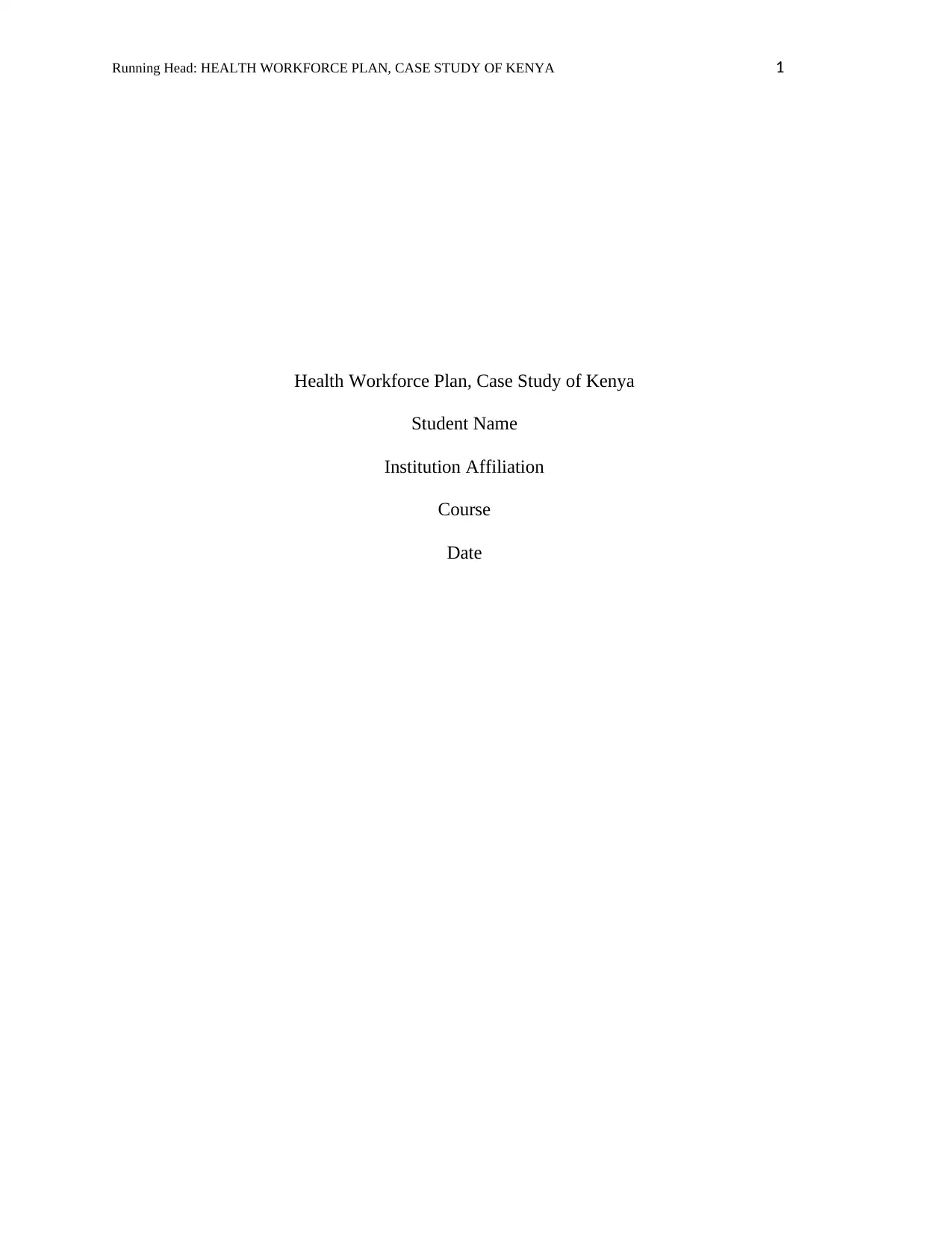
Running Head: HEALTH WORKFORCE PLAN, CASE STUDY OF KENYA 1
Health Workforce Plan, Case Study of Kenya
Student Name
Institution Affiliation
Course
Date
Health Workforce Plan, Case Study of Kenya
Student Name
Institution Affiliation
Course
Date
Paraphrase This Document
Need a fresh take? Get an instant paraphrase of this document with our AI Paraphraser
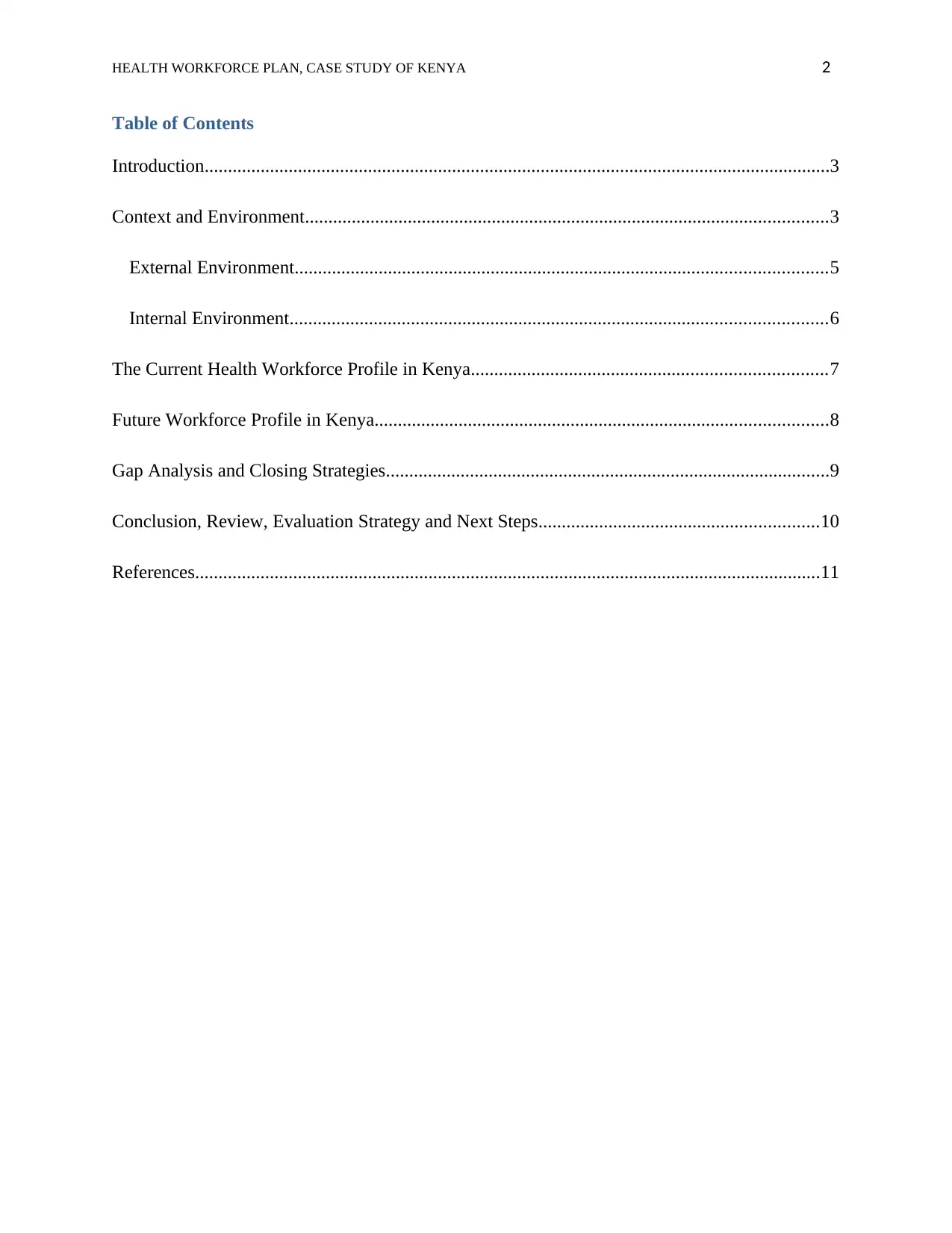
HEALTH WORKFORCE PLAN, CASE STUDY OF KENYA 2
Table of Contents
Introduction......................................................................................................................................3
Context and Environment................................................................................................................3
External Environment..................................................................................................................5
Internal Environment...................................................................................................................6
The Current Health Workforce Profile in Kenya............................................................................7
Future Workforce Profile in Kenya.................................................................................................8
Gap Analysis and Closing Strategies...............................................................................................9
Conclusion, Review, Evaluation Strategy and Next Steps............................................................10
References......................................................................................................................................11
Table of Contents
Introduction......................................................................................................................................3
Context and Environment................................................................................................................3
External Environment..................................................................................................................5
Internal Environment...................................................................................................................6
The Current Health Workforce Profile in Kenya............................................................................7
Future Workforce Profile in Kenya.................................................................................................8
Gap Analysis and Closing Strategies...............................................................................................9
Conclusion, Review, Evaluation Strategy and Next Steps............................................................10
References......................................................................................................................................11
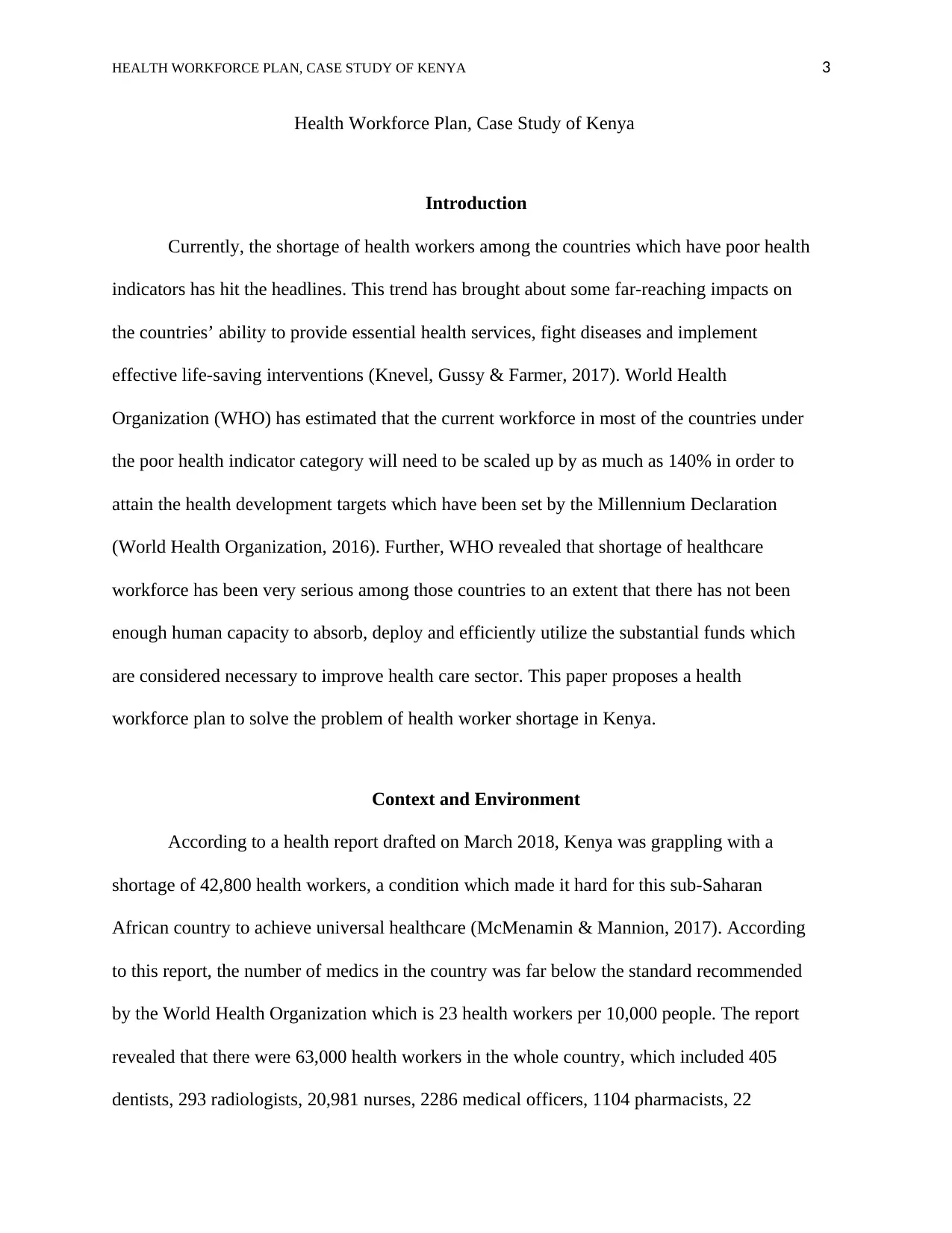
HEALTH WORKFORCE PLAN, CASE STUDY OF KENYA 3
Health Workforce Plan, Case Study of Kenya
Introduction
Currently, the shortage of health workers among the countries which have poor health
indicators has hit the headlines. This trend has brought about some far-reaching impacts on
the countries’ ability to provide essential health services, fight diseases and implement
effective life-saving interventions (Knevel, Gussy & Farmer, 2017). World Health
Organization (WHO) has estimated that the current workforce in most of the countries under
the poor health indicator category will need to be scaled up by as much as 140% in order to
attain the health development targets which have been set by the Millennium Declaration
(World Health Organization, 2016). Further, WHO revealed that shortage of healthcare
workforce has been very serious among those countries to an extent that there has not been
enough human capacity to absorb, deploy and efficiently utilize the substantial funds which
are considered necessary to improve health care sector. This paper proposes a health
workforce plan to solve the problem of health worker shortage in Kenya.
Context and Environment
According to a health report drafted on March 2018, Kenya was grappling with a
shortage of 42,800 health workers, a condition which made it hard for this sub-Saharan
African country to achieve universal healthcare (McMenamin & Mannion, 2017). According
to this report, the number of medics in the country was far below the standard recommended
by the World Health Organization which is 23 health workers per 10,000 people. The report
revealed that there were 63,000 health workers in the whole country, which included 405
dentists, 293 radiologists, 20,981 nurses, 2286 medical officers, 1104 pharmacists, 22
Health Workforce Plan, Case Study of Kenya
Introduction
Currently, the shortage of health workers among the countries which have poor health
indicators has hit the headlines. This trend has brought about some far-reaching impacts on
the countries’ ability to provide essential health services, fight diseases and implement
effective life-saving interventions (Knevel, Gussy & Farmer, 2017). World Health
Organization (WHO) has estimated that the current workforce in most of the countries under
the poor health indicator category will need to be scaled up by as much as 140% in order to
attain the health development targets which have been set by the Millennium Declaration
(World Health Organization, 2016). Further, WHO revealed that shortage of healthcare
workforce has been very serious among those countries to an extent that there has not been
enough human capacity to absorb, deploy and efficiently utilize the substantial funds which
are considered necessary to improve health care sector. This paper proposes a health
workforce plan to solve the problem of health worker shortage in Kenya.
Context and Environment
According to a health report drafted on March 2018, Kenya was grappling with a
shortage of 42,800 health workers, a condition which made it hard for this sub-Saharan
African country to achieve universal healthcare (McMenamin & Mannion, 2017). According
to this report, the number of medics in the country was far below the standard recommended
by the World Health Organization which is 23 health workers per 10,000 people. The report
revealed that there were 63,000 health workers in the whole country, which included 405
dentists, 293 radiologists, 20,981 nurses, 2286 medical officers, 1104 pharmacists, 22
⊘ This is a preview!⊘
Do you want full access?
Subscribe today to unlock all pages.

Trusted by 1+ million students worldwide
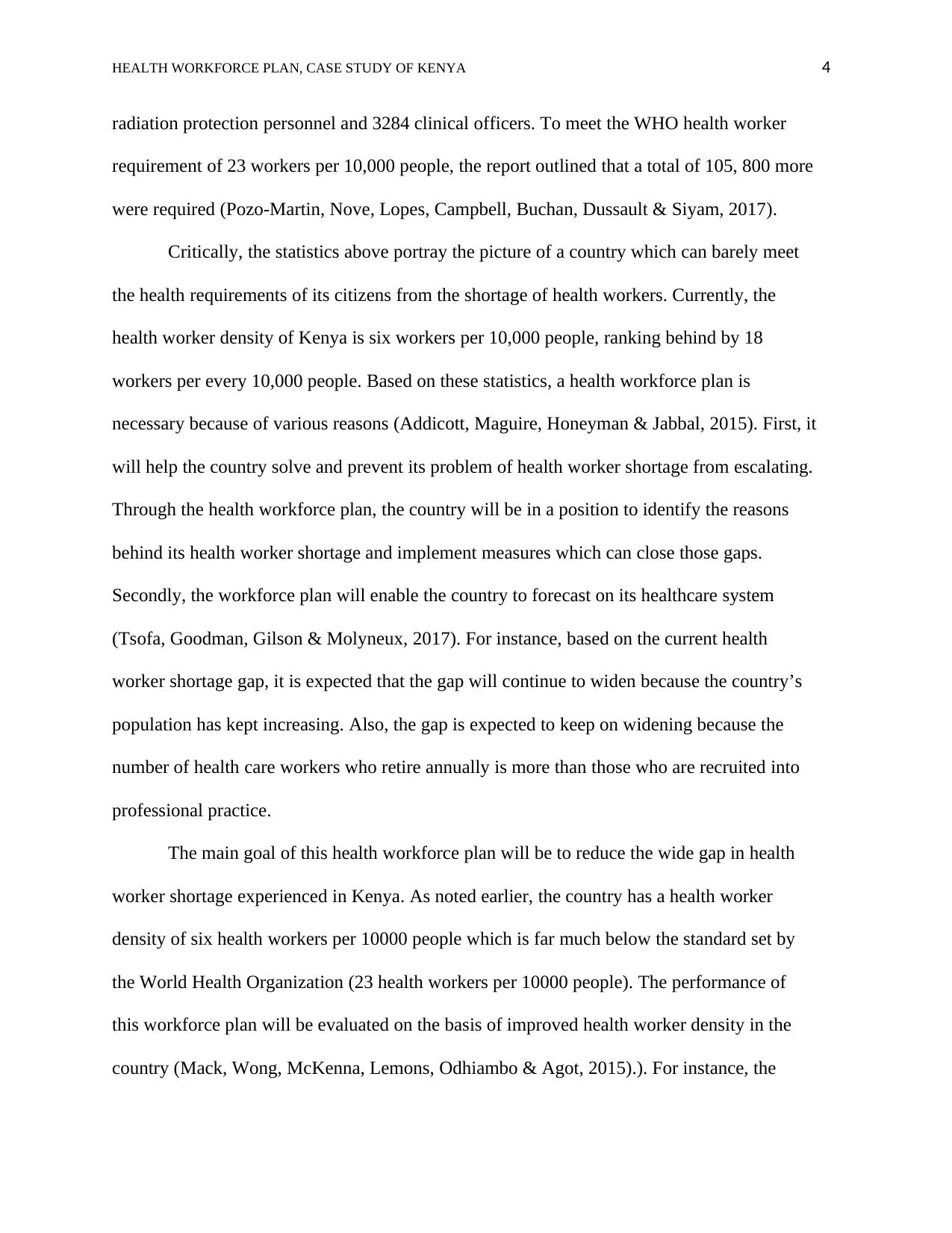
HEALTH WORKFORCE PLAN, CASE STUDY OF KENYA 4
radiation protection personnel and 3284 clinical officers. To meet the WHO health worker
requirement of 23 workers per 10,000 people, the report outlined that a total of 105, 800 more
were required (Pozo-Martin, Nove, Lopes, Campbell, Buchan, Dussault & Siyam, 2017).
Critically, the statistics above portray the picture of a country which can barely meet
the health requirements of its citizens from the shortage of health workers. Currently, the
health worker density of Kenya is six workers per 10,000 people, ranking behind by 18
workers per every 10,000 people. Based on these statistics, a health workforce plan is
necessary because of various reasons (Addicott, Maguire, Honeyman & Jabbal, 2015). First, it
will help the country solve and prevent its problem of health worker shortage from escalating.
Through the health workforce plan, the country will be in a position to identify the reasons
behind its health worker shortage and implement measures which can close those gaps.
Secondly, the workforce plan will enable the country to forecast on its healthcare system
(Tsofa, Goodman, Gilson & Molyneux, 2017). For instance, based on the current health
worker shortage gap, it is expected that the gap will continue to widen because the country’s
population has kept increasing. Also, the gap is expected to keep on widening because the
number of health care workers who retire annually is more than those who are recruited into
professional practice.
The main goal of this health workforce plan will be to reduce the wide gap in health
worker shortage experienced in Kenya. As noted earlier, the country has a health worker
density of six health workers per 10000 people which is far much below the standard set by
the World Health Organization (23 health workers per 10000 people). The performance of
this workforce plan will be evaluated on the basis of improved health worker density in the
country (Mack, Wong, McKenna, Lemons, Odhiambo & Agot, 2015).). For instance, the
radiation protection personnel and 3284 clinical officers. To meet the WHO health worker
requirement of 23 workers per 10,000 people, the report outlined that a total of 105, 800 more
were required (Pozo-Martin, Nove, Lopes, Campbell, Buchan, Dussault & Siyam, 2017).
Critically, the statistics above portray the picture of a country which can barely meet
the health requirements of its citizens from the shortage of health workers. Currently, the
health worker density of Kenya is six workers per 10,000 people, ranking behind by 18
workers per every 10,000 people. Based on these statistics, a health workforce plan is
necessary because of various reasons (Addicott, Maguire, Honeyman & Jabbal, 2015). First, it
will help the country solve and prevent its problem of health worker shortage from escalating.
Through the health workforce plan, the country will be in a position to identify the reasons
behind its health worker shortage and implement measures which can close those gaps.
Secondly, the workforce plan will enable the country to forecast on its healthcare system
(Tsofa, Goodman, Gilson & Molyneux, 2017). For instance, based on the current health
worker shortage gap, it is expected that the gap will continue to widen because the country’s
population has kept increasing. Also, the gap is expected to keep on widening because the
number of health care workers who retire annually is more than those who are recruited into
professional practice.
The main goal of this health workforce plan will be to reduce the wide gap in health
worker shortage experienced in Kenya. As noted earlier, the country has a health worker
density of six health workers per 10000 people which is far much below the standard set by
the World Health Organization (23 health workers per 10000 people). The performance of
this workforce plan will be evaluated on the basis of improved health worker density in the
country (Mack, Wong, McKenna, Lemons, Odhiambo & Agot, 2015).). For instance, the
Paraphrase This Document
Need a fresh take? Get an instant paraphrase of this document with our AI Paraphraser
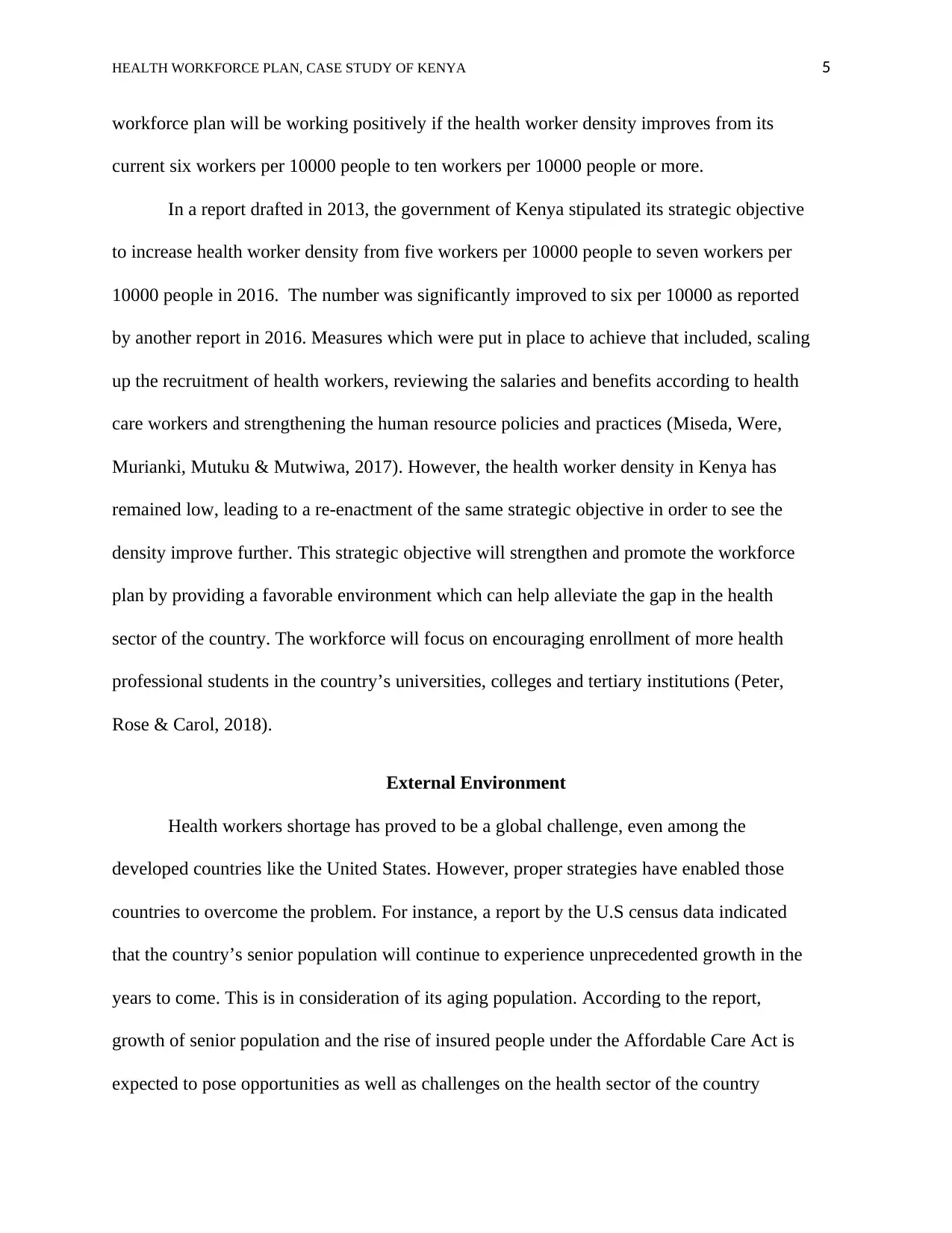
HEALTH WORKFORCE PLAN, CASE STUDY OF KENYA 5
workforce plan will be working positively if the health worker density improves from its
current six workers per 10000 people to ten workers per 10000 people or more.
In a report drafted in 2013, the government of Kenya stipulated its strategic objective
to increase health worker density from five workers per 10000 people to seven workers per
10000 people in 2016. The number was significantly improved to six per 10000 as reported
by another report in 2016. Measures which were put in place to achieve that included, scaling
up the recruitment of health workers, reviewing the salaries and benefits according to health
care workers and strengthening the human resource policies and practices (Miseda, Were,
Murianki, Mutuku & Mutwiwa, 2017). However, the health worker density in Kenya has
remained low, leading to a re-enactment of the same strategic objective in order to see the
density improve further. This strategic objective will strengthen and promote the workforce
plan by providing a favorable environment which can help alleviate the gap in the health
sector of the country. The workforce will focus on encouraging enrollment of more health
professional students in the country’s universities, colleges and tertiary institutions (Peter,
Rose & Carol, 2018).
External Environment
Health workers shortage has proved to be a global challenge, even among the
developed countries like the United States. However, proper strategies have enabled those
countries to overcome the problem. For instance, a report by the U.S census data indicated
that the country’s senior population will continue to experience unprecedented growth in the
years to come. This is in consideration of its aging population. According to the report,
growth of senior population and the rise of insured people under the Affordable Care Act is
expected to pose opportunities as well as challenges on the health sector of the country
workforce plan will be working positively if the health worker density improves from its
current six workers per 10000 people to ten workers per 10000 people or more.
In a report drafted in 2013, the government of Kenya stipulated its strategic objective
to increase health worker density from five workers per 10000 people to seven workers per
10000 people in 2016. The number was significantly improved to six per 10000 as reported
by another report in 2016. Measures which were put in place to achieve that included, scaling
up the recruitment of health workers, reviewing the salaries and benefits according to health
care workers and strengthening the human resource policies and practices (Miseda, Were,
Murianki, Mutuku & Mutwiwa, 2017). However, the health worker density in Kenya has
remained low, leading to a re-enactment of the same strategic objective in order to see the
density improve further. This strategic objective will strengthen and promote the workforce
plan by providing a favorable environment which can help alleviate the gap in the health
sector of the country. The workforce will focus on encouraging enrollment of more health
professional students in the country’s universities, colleges and tertiary institutions (Peter,
Rose & Carol, 2018).
External Environment
Health workers shortage has proved to be a global challenge, even among the
developed countries like the United States. However, proper strategies have enabled those
countries to overcome the problem. For instance, a report by the U.S census data indicated
that the country’s senior population will continue to experience unprecedented growth in the
years to come. This is in consideration of its aging population. According to the report,
growth of senior population and the rise of insured people under the Affordable Care Act is
expected to pose opportunities as well as challenges on the health sector of the country
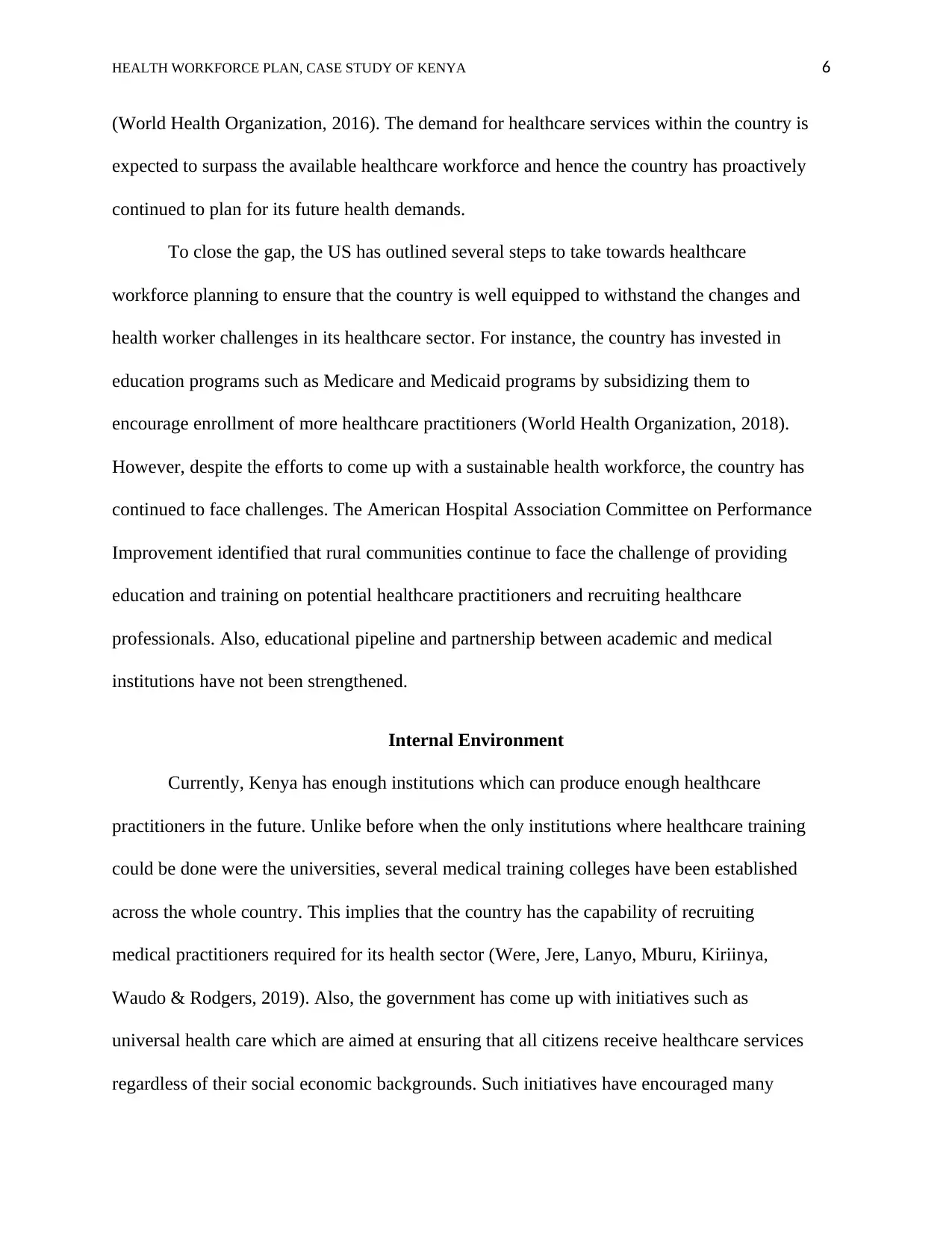
HEALTH WORKFORCE PLAN, CASE STUDY OF KENYA 6
(World Health Organization, 2016). The demand for healthcare services within the country is
expected to surpass the available healthcare workforce and hence the country has proactively
continued to plan for its future health demands.
To close the gap, the US has outlined several steps to take towards healthcare
workforce planning to ensure that the country is well equipped to withstand the changes and
health worker challenges in its healthcare sector. For instance, the country has invested in
education programs such as Medicare and Medicaid programs by subsidizing them to
encourage enrollment of more healthcare practitioners (World Health Organization, 2018).
However, despite the efforts to come up with a sustainable health workforce, the country has
continued to face challenges. The American Hospital Association Committee on Performance
Improvement identified that rural communities continue to face the challenge of providing
education and training on potential healthcare practitioners and recruiting healthcare
professionals. Also, educational pipeline and partnership between academic and medical
institutions have not been strengthened.
Internal Environment
Currently, Kenya has enough institutions which can produce enough healthcare
practitioners in the future. Unlike before when the only institutions where healthcare training
could be done were the universities, several medical training colleges have been established
across the whole country. This implies that the country has the capability of recruiting
medical practitioners required for its health sector (Were, Jere, Lanyo, Mburu, Kiriinya,
Waudo & Rodgers, 2019). Also, the government has come up with initiatives such as
universal health care which are aimed at ensuring that all citizens receive healthcare services
regardless of their social economic backgrounds. Such initiatives have encouraged many
(World Health Organization, 2016). The demand for healthcare services within the country is
expected to surpass the available healthcare workforce and hence the country has proactively
continued to plan for its future health demands.
To close the gap, the US has outlined several steps to take towards healthcare
workforce planning to ensure that the country is well equipped to withstand the changes and
health worker challenges in its healthcare sector. For instance, the country has invested in
education programs such as Medicare and Medicaid programs by subsidizing them to
encourage enrollment of more healthcare practitioners (World Health Organization, 2018).
However, despite the efforts to come up with a sustainable health workforce, the country has
continued to face challenges. The American Hospital Association Committee on Performance
Improvement identified that rural communities continue to face the challenge of providing
education and training on potential healthcare practitioners and recruiting healthcare
professionals. Also, educational pipeline and partnership between academic and medical
institutions have not been strengthened.
Internal Environment
Currently, Kenya has enough institutions which can produce enough healthcare
practitioners in the future. Unlike before when the only institutions where healthcare training
could be done were the universities, several medical training colleges have been established
across the whole country. This implies that the country has the capability of recruiting
medical practitioners required for its health sector (Were, Jere, Lanyo, Mburu, Kiriinya,
Waudo & Rodgers, 2019). Also, the government has come up with initiatives such as
universal health care which are aimed at ensuring that all citizens receive healthcare services
regardless of their social economic backgrounds. Such initiatives have encouraged many
⊘ This is a preview!⊘
Do you want full access?
Subscribe today to unlock all pages.

Trusted by 1+ million students worldwide
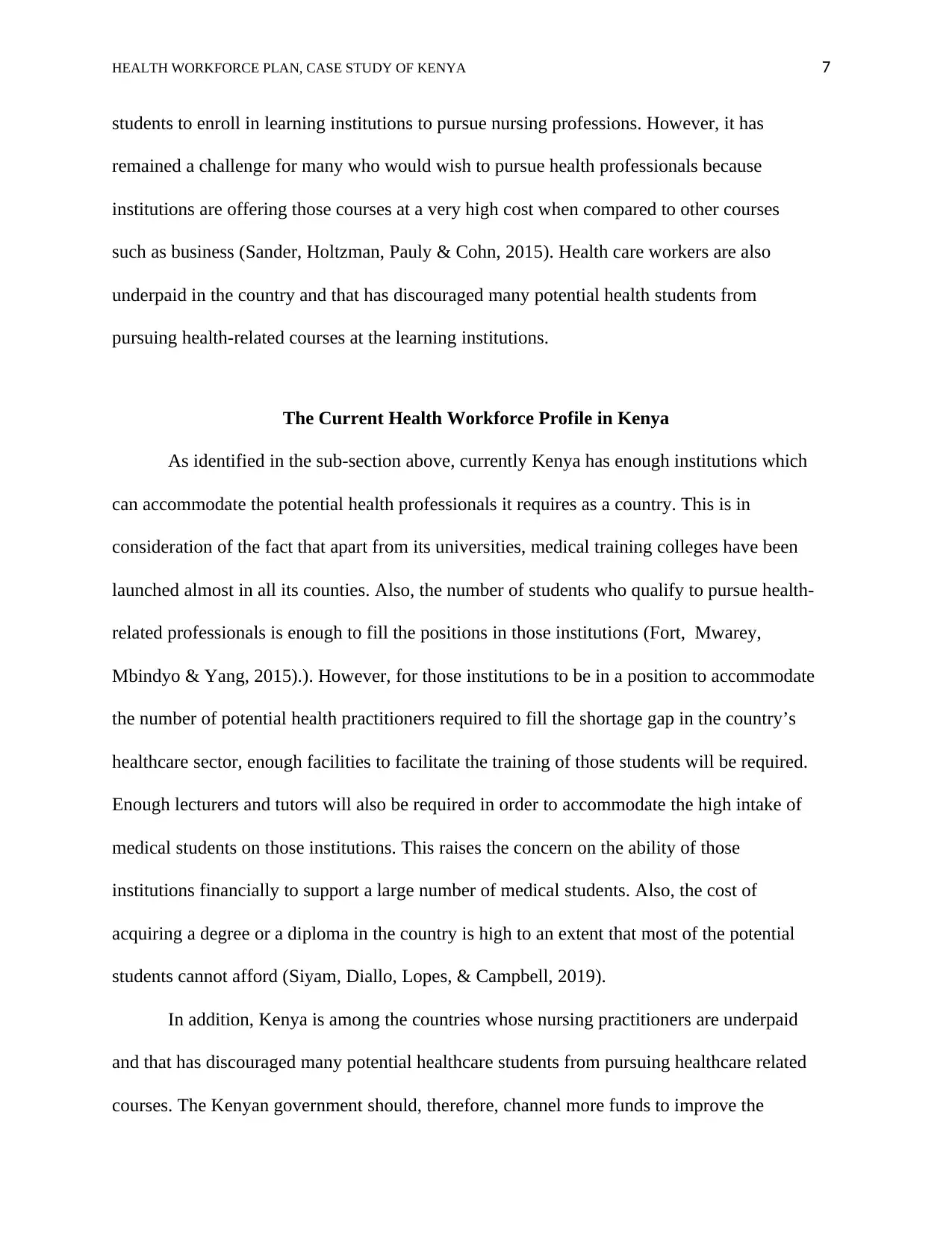
HEALTH WORKFORCE PLAN, CASE STUDY OF KENYA 7
students to enroll in learning institutions to pursue nursing professions. However, it has
remained a challenge for many who would wish to pursue health professionals because
institutions are offering those courses at a very high cost when compared to other courses
such as business (Sander, Holtzman, Pauly & Cohn, 2015). Health care workers are also
underpaid in the country and that has discouraged many potential health students from
pursuing health-related courses at the learning institutions.
The Current Health Workforce Profile in Kenya
As identified in the sub-section above, currently Kenya has enough institutions which
can accommodate the potential health professionals it requires as a country. This is in
consideration of the fact that apart from its universities, medical training colleges have been
launched almost in all its counties. Also, the number of students who qualify to pursue health-
related professionals is enough to fill the positions in those institutions (Fort, Mwarey,
Mbindyo & Yang, 2015).). However, for those institutions to be in a position to accommodate
the number of potential health practitioners required to fill the shortage gap in the country’s
healthcare sector, enough facilities to facilitate the training of those students will be required.
Enough lecturers and tutors will also be required in order to accommodate the high intake of
medical students on those institutions. This raises the concern on the ability of those
institutions financially to support a large number of medical students. Also, the cost of
acquiring a degree or a diploma in the country is high to an extent that most of the potential
students cannot afford (Siyam, Diallo, Lopes, & Campbell, 2019).
In addition, Kenya is among the countries whose nursing practitioners are underpaid
and that has discouraged many potential healthcare students from pursuing healthcare related
courses. The Kenyan government should, therefore, channel more funds to improve the
students to enroll in learning institutions to pursue nursing professions. However, it has
remained a challenge for many who would wish to pursue health professionals because
institutions are offering those courses at a very high cost when compared to other courses
such as business (Sander, Holtzman, Pauly & Cohn, 2015). Health care workers are also
underpaid in the country and that has discouraged many potential health students from
pursuing health-related courses at the learning institutions.
The Current Health Workforce Profile in Kenya
As identified in the sub-section above, currently Kenya has enough institutions which
can accommodate the potential health professionals it requires as a country. This is in
consideration of the fact that apart from its universities, medical training colleges have been
launched almost in all its counties. Also, the number of students who qualify to pursue health-
related professionals is enough to fill the positions in those institutions (Fort, Mwarey,
Mbindyo & Yang, 2015).). However, for those institutions to be in a position to accommodate
the number of potential health practitioners required to fill the shortage gap in the country’s
healthcare sector, enough facilities to facilitate the training of those students will be required.
Enough lecturers and tutors will also be required in order to accommodate the high intake of
medical students on those institutions. This raises the concern on the ability of those
institutions financially to support a large number of medical students. Also, the cost of
acquiring a degree or a diploma in the country is high to an extent that most of the potential
students cannot afford (Siyam, Diallo, Lopes, & Campbell, 2019).
In addition, Kenya is among the countries whose nursing practitioners are underpaid
and that has discouraged many potential healthcare students from pursuing healthcare related
courses. The Kenyan government should, therefore, channel more funds to improve the
Paraphrase This Document
Need a fresh take? Get an instant paraphrase of this document with our AI Paraphraser
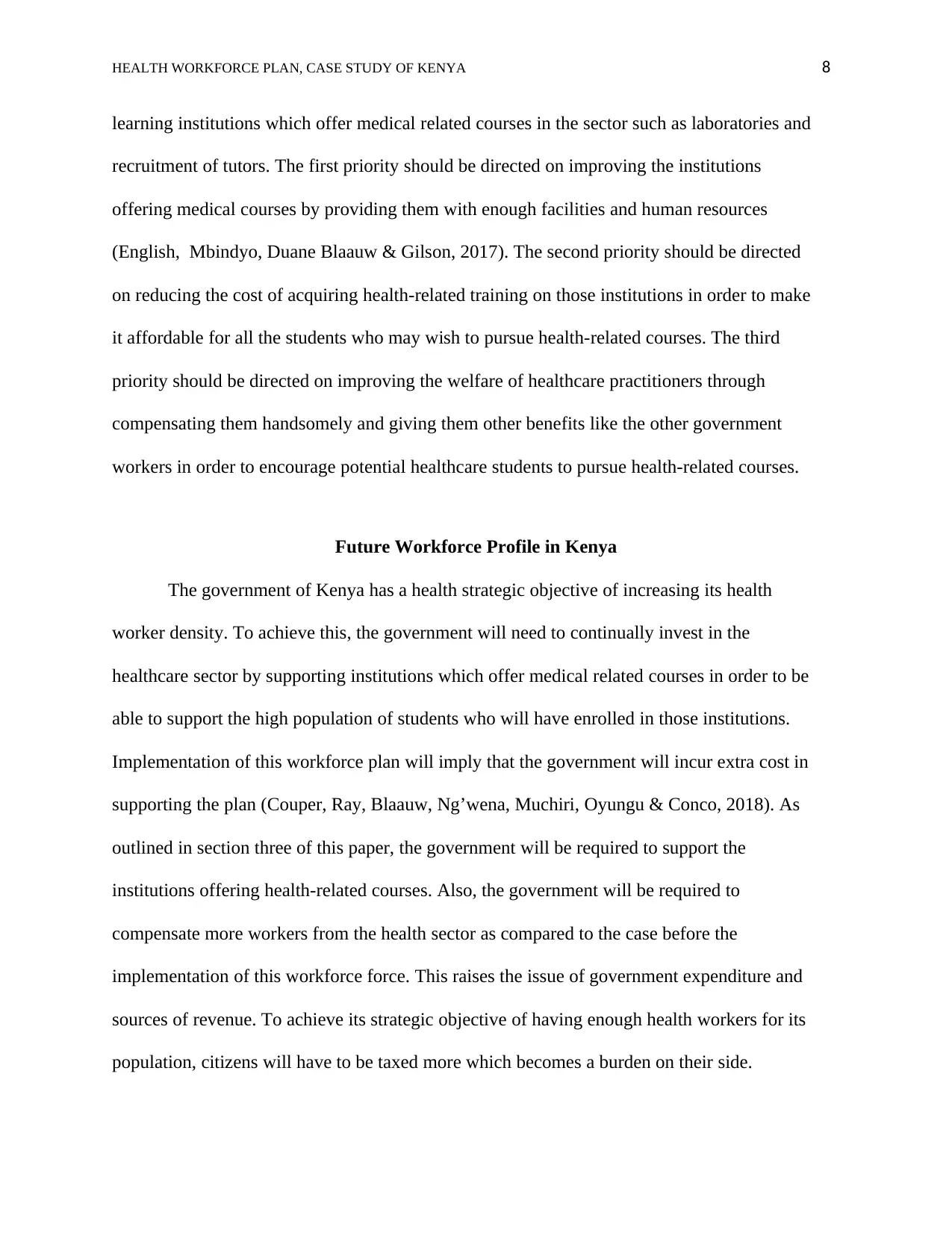
HEALTH WORKFORCE PLAN, CASE STUDY OF KENYA 8
learning institutions which offer medical related courses in the sector such as laboratories and
recruitment of tutors. The first priority should be directed on improving the institutions
offering medical courses by providing them with enough facilities and human resources
(English, Mbindyo, Duane Blaauw & Gilson, 2017). The second priority should be directed
on reducing the cost of acquiring health-related training on those institutions in order to make
it affordable for all the students who may wish to pursue health-related courses. The third
priority should be directed on improving the welfare of healthcare practitioners through
compensating them handsomely and giving them other benefits like the other government
workers in order to encourage potential healthcare students to pursue health-related courses.
Future Workforce Profile in Kenya
The government of Kenya has a health strategic objective of increasing its health
worker density. To achieve this, the government will need to continually invest in the
healthcare sector by supporting institutions which offer medical related courses in order to be
able to support the high population of students who will have enrolled in those institutions.
Implementation of this workforce plan will imply that the government will incur extra cost in
supporting the plan (Couper, Ray, Blaauw, Ng’wena, Muchiri, Oyungu & Conco, 2018). As
outlined in section three of this paper, the government will be required to support the
institutions offering health-related courses. Also, the government will be required to
compensate more workers from the health sector as compared to the case before the
implementation of this workforce force. This raises the issue of government expenditure and
sources of revenue. To achieve its strategic objective of having enough health workers for its
population, citizens will have to be taxed more which becomes a burden on their side.
learning institutions which offer medical related courses in the sector such as laboratories and
recruitment of tutors. The first priority should be directed on improving the institutions
offering medical courses by providing them with enough facilities and human resources
(English, Mbindyo, Duane Blaauw & Gilson, 2017). The second priority should be directed
on reducing the cost of acquiring health-related training on those institutions in order to make
it affordable for all the students who may wish to pursue health-related courses. The third
priority should be directed on improving the welfare of healthcare practitioners through
compensating them handsomely and giving them other benefits like the other government
workers in order to encourage potential healthcare students to pursue health-related courses.
Future Workforce Profile in Kenya
The government of Kenya has a health strategic objective of increasing its health
worker density. To achieve this, the government will need to continually invest in the
healthcare sector by supporting institutions which offer medical related courses in order to be
able to support the high population of students who will have enrolled in those institutions.
Implementation of this workforce plan will imply that the government will incur extra cost in
supporting the plan (Couper, Ray, Blaauw, Ng’wena, Muchiri, Oyungu & Conco, 2018). As
outlined in section three of this paper, the government will be required to support the
institutions offering health-related courses. Also, the government will be required to
compensate more workers from the health sector as compared to the case before the
implementation of this workforce force. This raises the issue of government expenditure and
sources of revenue. To achieve its strategic objective of having enough health workers for its
population, citizens will have to be taxed more which becomes a burden on their side.
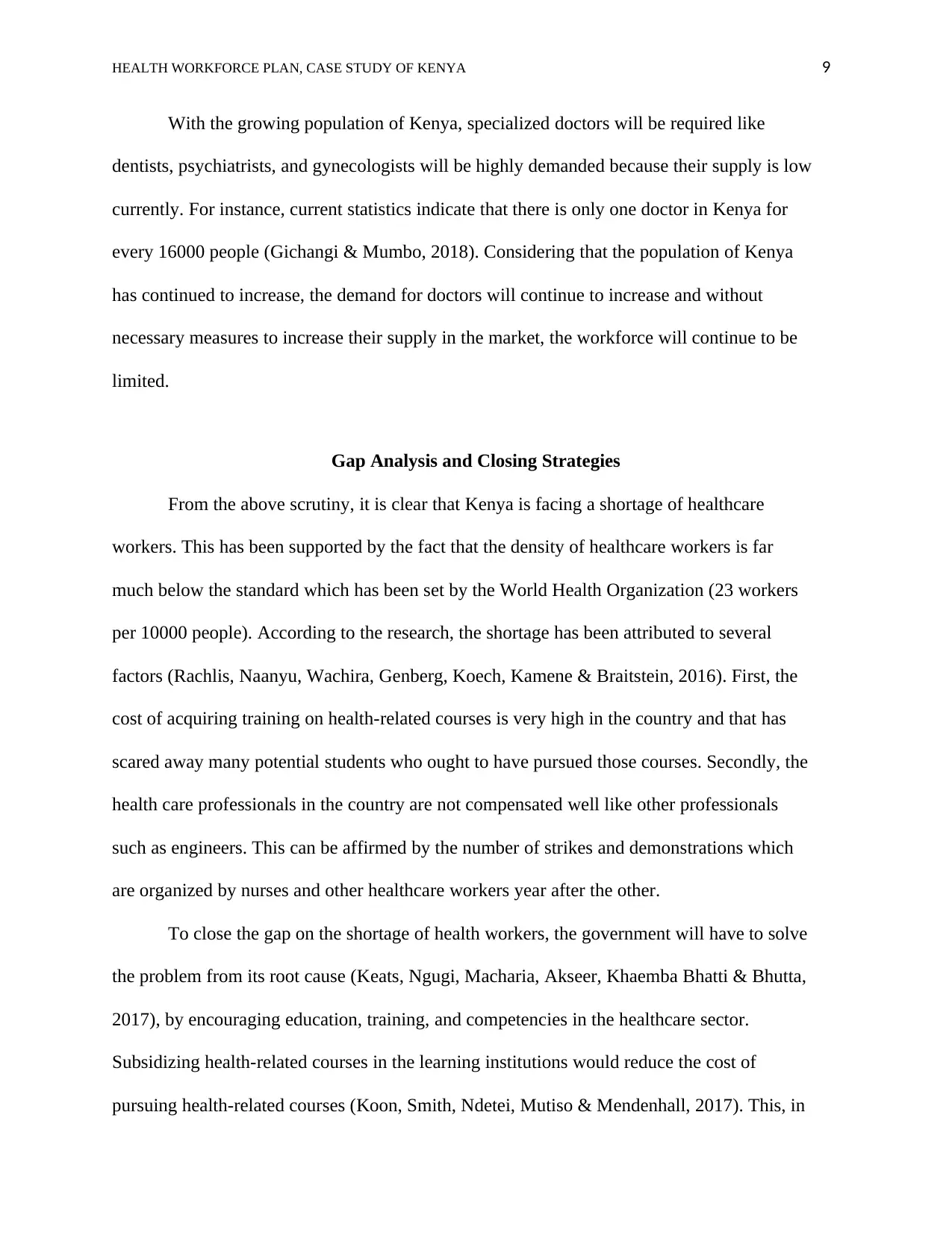
HEALTH WORKFORCE PLAN, CASE STUDY OF KENYA 9
With the growing population of Kenya, specialized doctors will be required like
dentists, psychiatrists, and gynecologists will be highly demanded because their supply is low
currently. For instance, current statistics indicate that there is only one doctor in Kenya for
every 16000 people (Gichangi & Mumbo, 2018). Considering that the population of Kenya
has continued to increase, the demand for doctors will continue to increase and without
necessary measures to increase their supply in the market, the workforce will continue to be
limited.
Gap Analysis and Closing Strategies
From the above scrutiny, it is clear that Kenya is facing a shortage of healthcare
workers. This has been supported by the fact that the density of healthcare workers is far
much below the standard which has been set by the World Health Organization (23 workers
per 10000 people). According to the research, the shortage has been attributed to several
factors (Rachlis, Naanyu, Wachira, Genberg, Koech, Kamene & Braitstein, 2016). First, the
cost of acquiring training on health-related courses is very high in the country and that has
scared away many potential students who ought to have pursued those courses. Secondly, the
health care professionals in the country are not compensated well like other professionals
such as engineers. This can be affirmed by the number of strikes and demonstrations which
are organized by nurses and other healthcare workers year after the other.
To close the gap on the shortage of health workers, the government will have to solve
the problem from its root cause (Keats, Ngugi, Macharia, Akseer, Khaemba Bhatti & Bhutta,
2017), by encouraging education, training, and competencies in the healthcare sector.
Subsidizing health-related courses in the learning institutions would reduce the cost of
pursuing health-related courses (Koon, Smith, Ndetei, Mutiso & Mendenhall, 2017). This, in
With the growing population of Kenya, specialized doctors will be required like
dentists, psychiatrists, and gynecologists will be highly demanded because their supply is low
currently. For instance, current statistics indicate that there is only one doctor in Kenya for
every 16000 people (Gichangi & Mumbo, 2018). Considering that the population of Kenya
has continued to increase, the demand for doctors will continue to increase and without
necessary measures to increase their supply in the market, the workforce will continue to be
limited.
Gap Analysis and Closing Strategies
From the above scrutiny, it is clear that Kenya is facing a shortage of healthcare
workers. This has been supported by the fact that the density of healthcare workers is far
much below the standard which has been set by the World Health Organization (23 workers
per 10000 people). According to the research, the shortage has been attributed to several
factors (Rachlis, Naanyu, Wachira, Genberg, Koech, Kamene & Braitstein, 2016). First, the
cost of acquiring training on health-related courses is very high in the country and that has
scared away many potential students who ought to have pursued those courses. Secondly, the
health care professionals in the country are not compensated well like other professionals
such as engineers. This can be affirmed by the number of strikes and demonstrations which
are organized by nurses and other healthcare workers year after the other.
To close the gap on the shortage of health workers, the government will have to solve
the problem from its root cause (Keats, Ngugi, Macharia, Akseer, Khaemba Bhatti & Bhutta,
2017), by encouraging education, training, and competencies in the healthcare sector.
Subsidizing health-related courses in the learning institutions would reduce the cost of
pursuing health-related courses (Koon, Smith, Ndetei, Mutiso & Mendenhall, 2017). This, in
⊘ This is a preview!⊘
Do you want full access?
Subscribe today to unlock all pages.

Trusted by 1+ million students worldwide
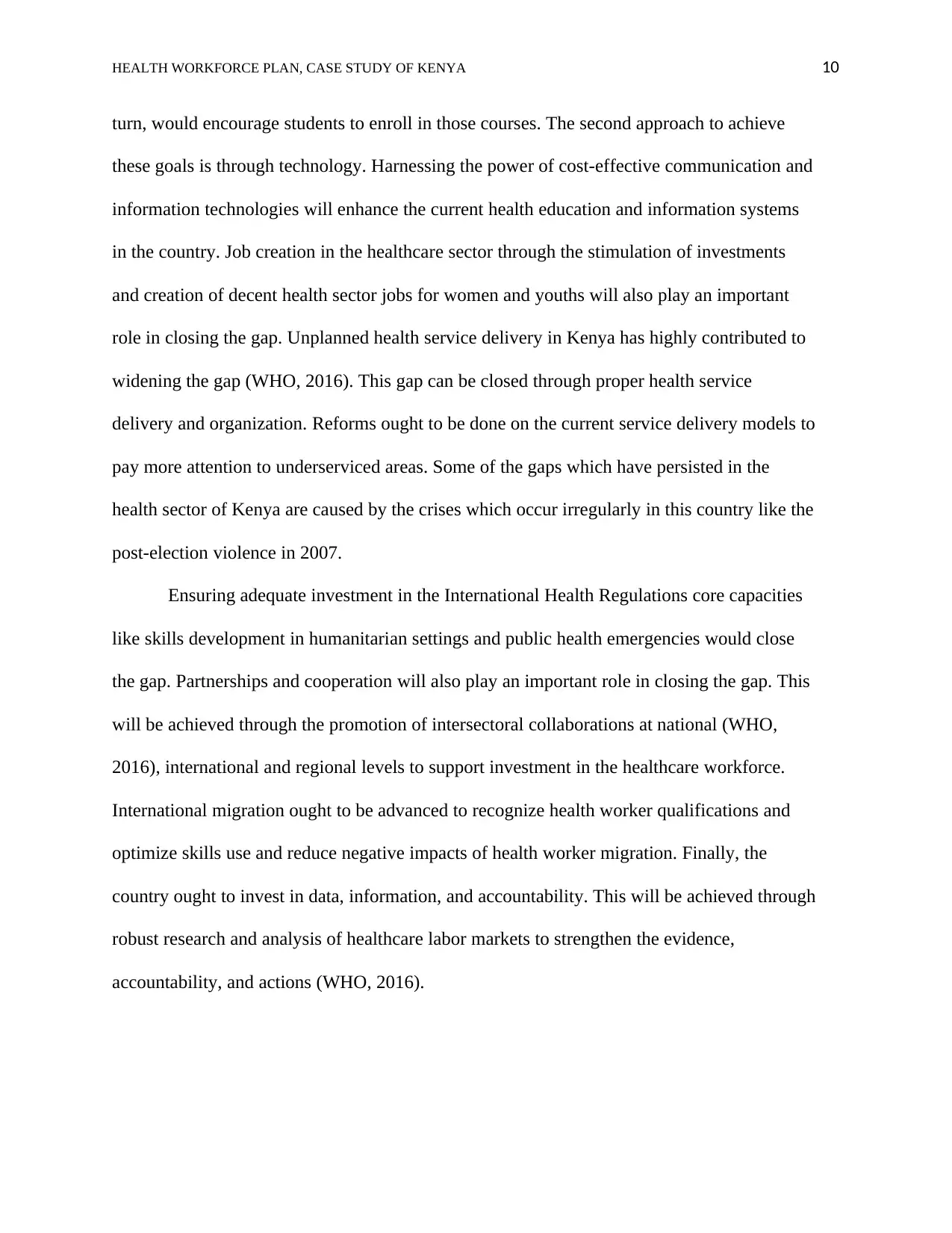
HEALTH WORKFORCE PLAN, CASE STUDY OF KENYA 10
turn, would encourage students to enroll in those courses. The second approach to achieve
these goals is through technology. Harnessing the power of cost-effective communication and
information technologies will enhance the current health education and information systems
in the country. Job creation in the healthcare sector through the stimulation of investments
and creation of decent health sector jobs for women and youths will also play an important
role in closing the gap. Unplanned health service delivery in Kenya has highly contributed to
widening the gap (WHO, 2016). This gap can be closed through proper health service
delivery and organization. Reforms ought to be done on the current service delivery models to
pay more attention to underserviced areas. Some of the gaps which have persisted in the
health sector of Kenya are caused by the crises which occur irregularly in this country like the
post-election violence in 2007.
Ensuring adequate investment in the International Health Regulations core capacities
like skills development in humanitarian settings and public health emergencies would close
the gap. Partnerships and cooperation will also play an important role in closing the gap. This
will be achieved through the promotion of intersectoral collaborations at national (WHO,
2016), international and regional levels to support investment in the healthcare workforce.
International migration ought to be advanced to recognize health worker qualifications and
optimize skills use and reduce negative impacts of health worker migration. Finally, the
country ought to invest in data, information, and accountability. This will be achieved through
robust research and analysis of healthcare labor markets to strengthen the evidence,
accountability, and actions (WHO, 2016).
turn, would encourage students to enroll in those courses. The second approach to achieve
these goals is through technology. Harnessing the power of cost-effective communication and
information technologies will enhance the current health education and information systems
in the country. Job creation in the healthcare sector through the stimulation of investments
and creation of decent health sector jobs for women and youths will also play an important
role in closing the gap. Unplanned health service delivery in Kenya has highly contributed to
widening the gap (WHO, 2016). This gap can be closed through proper health service
delivery and organization. Reforms ought to be done on the current service delivery models to
pay more attention to underserviced areas. Some of the gaps which have persisted in the
health sector of Kenya are caused by the crises which occur irregularly in this country like the
post-election violence in 2007.
Ensuring adequate investment in the International Health Regulations core capacities
like skills development in humanitarian settings and public health emergencies would close
the gap. Partnerships and cooperation will also play an important role in closing the gap. This
will be achieved through the promotion of intersectoral collaborations at national (WHO,
2016), international and regional levels to support investment in the healthcare workforce.
International migration ought to be advanced to recognize health worker qualifications and
optimize skills use and reduce negative impacts of health worker migration. Finally, the
country ought to invest in data, information, and accountability. This will be achieved through
robust research and analysis of healthcare labor markets to strengthen the evidence,
accountability, and actions (WHO, 2016).
Paraphrase This Document
Need a fresh take? Get an instant paraphrase of this document with our AI Paraphraser
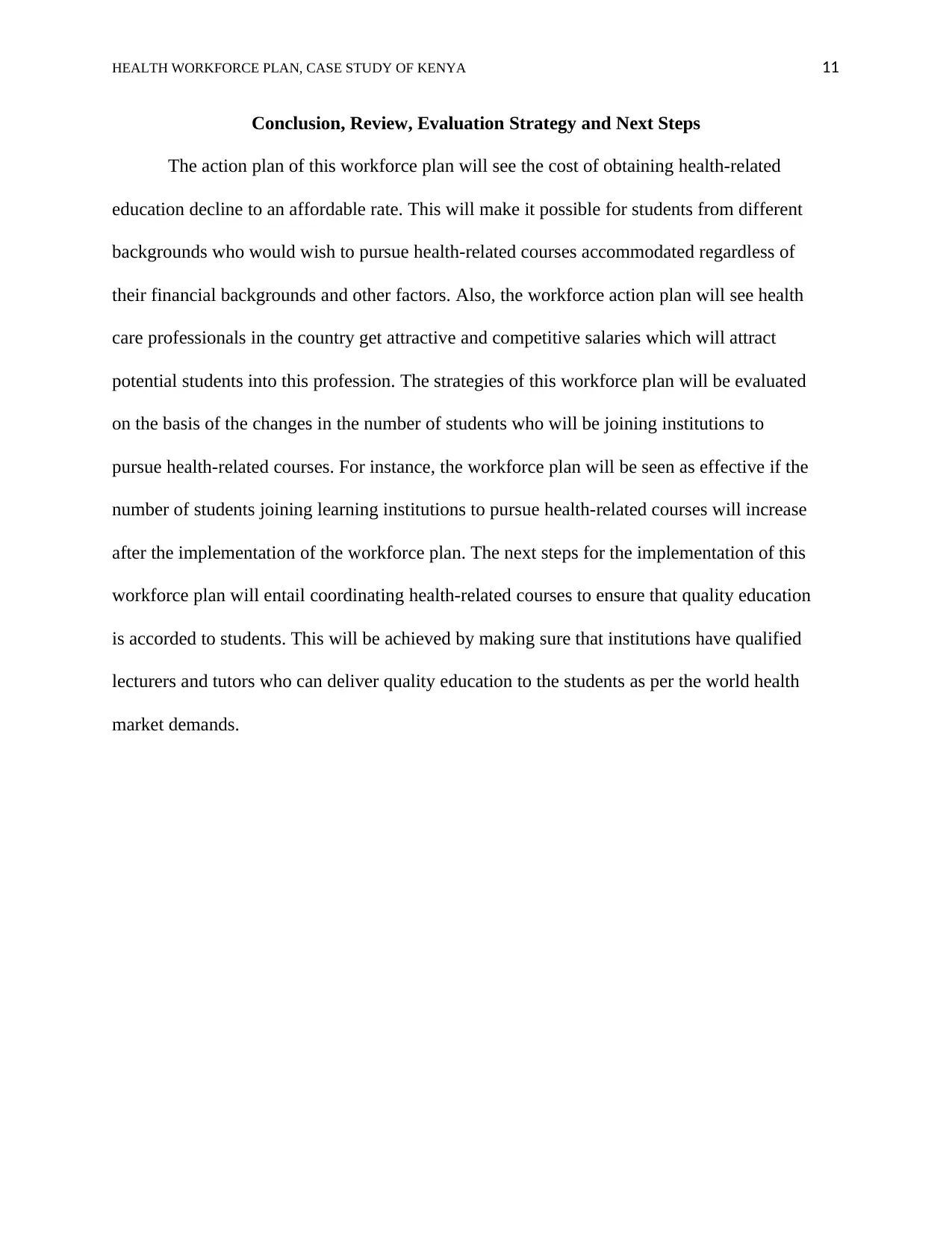
HEALTH WORKFORCE PLAN, CASE STUDY OF KENYA 11
Conclusion, Review, Evaluation Strategy and Next Steps
The action plan of this workforce plan will see the cost of obtaining health-related
education decline to an affordable rate. This will make it possible for students from different
backgrounds who would wish to pursue health-related courses accommodated regardless of
their financial backgrounds and other factors. Also, the workforce action plan will see health
care professionals in the country get attractive and competitive salaries which will attract
potential students into this profession. The strategies of this workforce plan will be evaluated
on the basis of the changes in the number of students who will be joining institutions to
pursue health-related courses. For instance, the workforce plan will be seen as effective if the
number of students joining learning institutions to pursue health-related courses will increase
after the implementation of the workforce plan. The next steps for the implementation of this
workforce plan will entail coordinating health-related courses to ensure that quality education
is accorded to students. This will be achieved by making sure that institutions have qualified
lecturers and tutors who can deliver quality education to the students as per the world health
market demands.
Conclusion, Review, Evaluation Strategy and Next Steps
The action plan of this workforce plan will see the cost of obtaining health-related
education decline to an affordable rate. This will make it possible for students from different
backgrounds who would wish to pursue health-related courses accommodated regardless of
their financial backgrounds and other factors. Also, the workforce action plan will see health
care professionals in the country get attractive and competitive salaries which will attract
potential students into this profession. The strategies of this workforce plan will be evaluated
on the basis of the changes in the number of students who will be joining institutions to
pursue health-related courses. For instance, the workforce plan will be seen as effective if the
number of students joining learning institutions to pursue health-related courses will increase
after the implementation of the workforce plan. The next steps for the implementation of this
workforce plan will entail coordinating health-related courses to ensure that quality education
is accorded to students. This will be achieved by making sure that institutions have qualified
lecturers and tutors who can deliver quality education to the students as per the world health
market demands.
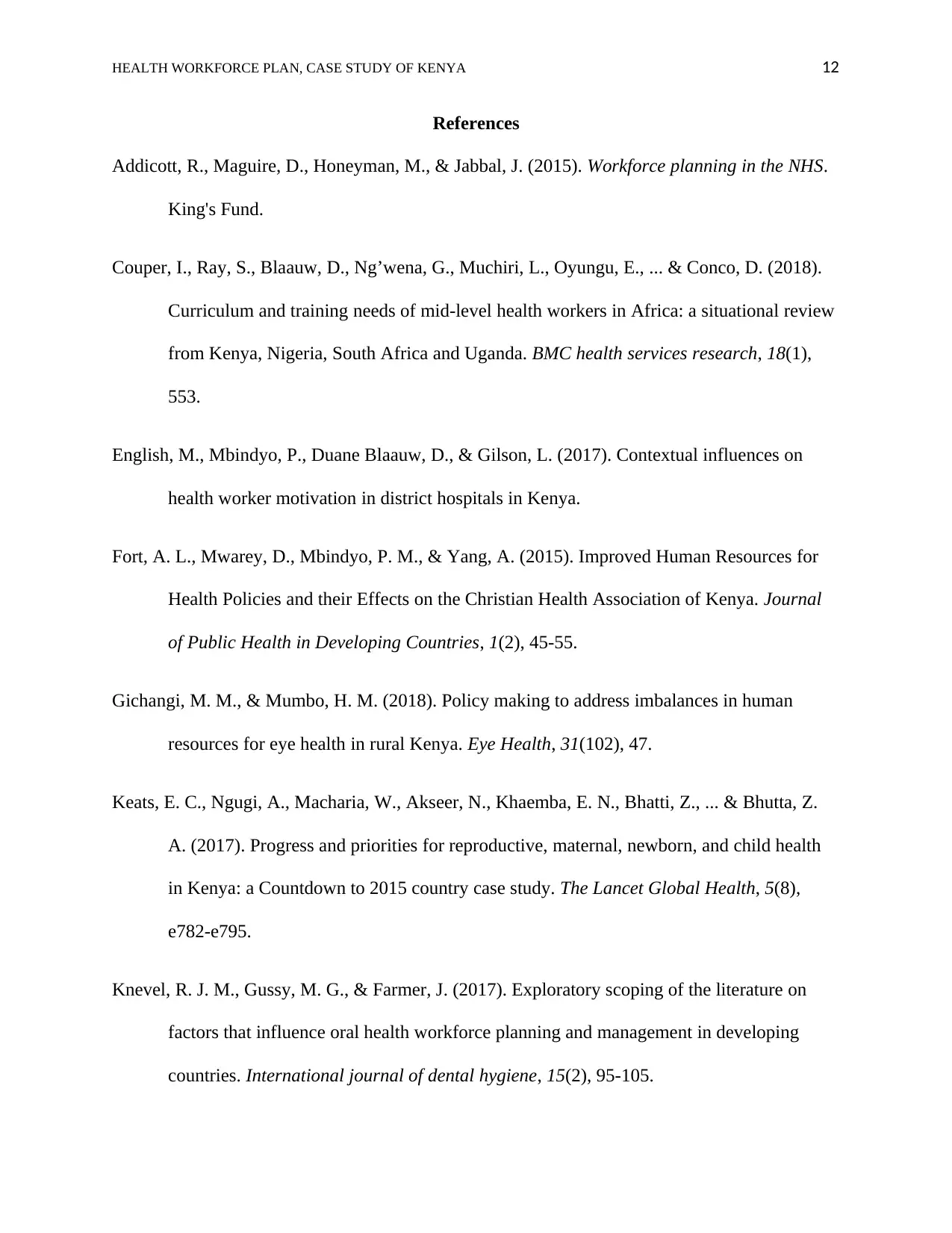
HEALTH WORKFORCE PLAN, CASE STUDY OF KENYA 12
References
Addicott, R., Maguire, D., Honeyman, M., & Jabbal, J. (2015). Workforce planning in the NHS.
King's Fund.
Couper, I., Ray, S., Blaauw, D., Ng’wena, G., Muchiri, L., Oyungu, E., ... & Conco, D. (2018).
Curriculum and training needs of mid-level health workers in Africa: a situational review
from Kenya, Nigeria, South Africa and Uganda. BMC health services research, 18(1),
553.
English, M., Mbindyo, P., Duane Blaauw, D., & Gilson, L. (2017). Contextual influences on
health worker motivation in district hospitals in Kenya.
Fort, A. L., Mwarey, D., Mbindyo, P. M., & Yang, A. (2015). Improved Human Resources for
Health Policies and their Effects on the Christian Health Association of Kenya. Journal
of Public Health in Developing Countries, 1(2), 45-55.
Gichangi, M. M., & Mumbo, H. M. (2018). Policy making to address imbalances in human
resources for eye health in rural Kenya. Eye Health, 31(102), 47.
Keats, E. C., Ngugi, A., Macharia, W., Akseer, N., Khaemba, E. N., Bhatti, Z., ... & Bhutta, Z.
A. (2017). Progress and priorities for reproductive, maternal, newborn, and child health
in Kenya: a Countdown to 2015 country case study. The Lancet Global Health, 5(8),
e782-e795.
Knevel, R. J. M., Gussy, M. G., & Farmer, J. (2017). Exploratory scoping of the literature on
factors that influence oral health workforce planning and management in developing
countries. International journal of dental hygiene, 15(2), 95-105.
References
Addicott, R., Maguire, D., Honeyman, M., & Jabbal, J. (2015). Workforce planning in the NHS.
King's Fund.
Couper, I., Ray, S., Blaauw, D., Ng’wena, G., Muchiri, L., Oyungu, E., ... & Conco, D. (2018).
Curriculum and training needs of mid-level health workers in Africa: a situational review
from Kenya, Nigeria, South Africa and Uganda. BMC health services research, 18(1),
553.
English, M., Mbindyo, P., Duane Blaauw, D., & Gilson, L. (2017). Contextual influences on
health worker motivation in district hospitals in Kenya.
Fort, A. L., Mwarey, D., Mbindyo, P. M., & Yang, A. (2015). Improved Human Resources for
Health Policies and their Effects on the Christian Health Association of Kenya. Journal
of Public Health in Developing Countries, 1(2), 45-55.
Gichangi, M. M., & Mumbo, H. M. (2018). Policy making to address imbalances in human
resources for eye health in rural Kenya. Eye Health, 31(102), 47.
Keats, E. C., Ngugi, A., Macharia, W., Akseer, N., Khaemba, E. N., Bhatti, Z., ... & Bhutta, Z.
A. (2017). Progress and priorities for reproductive, maternal, newborn, and child health
in Kenya: a Countdown to 2015 country case study. The Lancet Global Health, 5(8),
e782-e795.
Knevel, R. J. M., Gussy, M. G., & Farmer, J. (2017). Exploratory scoping of the literature on
factors that influence oral health workforce planning and management in developing
countries. International journal of dental hygiene, 15(2), 95-105.
⊘ This is a preview!⊘
Do you want full access?
Subscribe today to unlock all pages.

Trusted by 1+ million students worldwide
1 out of 14
Related Documents
Your All-in-One AI-Powered Toolkit for Academic Success.
+13062052269
info@desklib.com
Available 24*7 on WhatsApp / Email
![[object Object]](/_next/static/media/star-bottom.7253800d.svg)
Unlock your academic potential
Copyright © 2020–2025 A2Z Services. All Rights Reserved. Developed and managed by ZUCOL.





